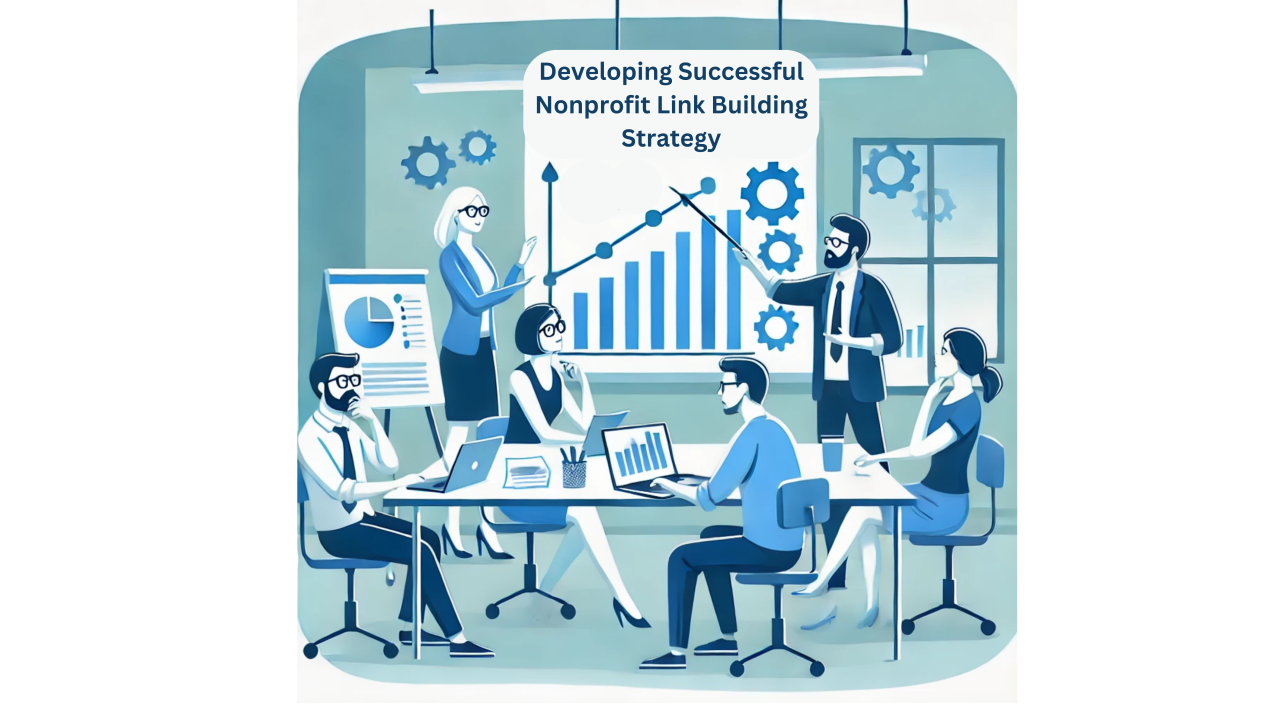Nonprofit organizations aim to impact positively but often need help to reach their target audience. Effective link building is crucial for improving a nonprofit’s Search Engine Optimization (SEO), enhancing online visibility, and attracting donors and volunteers. This article will delve into nonprofit link building, exploring its benefits for your digital marketing strategy.
SEO is vital for driving traffic to your nonprofit’s website, and link building is a key component of SEO success. By developing a tailored nonprofit link building strategy, nonprofits can boost their website rankings and strengthen their online presence. We will cover practical tactics for acquiring links, measuring link building success, and avoiding common pitfalls.
Key Takeaways
- Nonprofit link building is essential for improving SEO and online visibility.
- A tailored nonprofit link building strategy enhances your organization’s digital marketing efforts.
- Effective tactics and measuring success will contribute to long-term link building success.
Understanding Link Building for Nonprofits
As a nonprofit organization, you might wonder how nonprofit link building can benefit your cause. Link building is a crucial part of search engine optimization (SEO) that helps improve your online visibility and attract more visitors to your website. Building a strong link profile allows your nonprofit to expand its reach, create partnerships, and ultimately further its mission.
First, let’s define link building. It’s the process of obtaining hyperlinks from other websites to your own. This is important for nonprofits because search engines, like Google, use these backlinks to measure your website’s credibility and authority. The more high-quality and relevant backlinks you have, the better your search engine ranking will be, making it easier for people to find and support your nonprofit.
To help your nonprofit thrive in the digital world, here are some key link building strategies:
- Guest posting: Write content for other relevant websites in your industry or niche. Guest posting establishes your nonprofit as an expert in your field, builds trust among readers, and provides valuable backlinks to your website.
- Partnerships: Develop relationships with other nonprofits, businesses, or media outlets that share your values and goals. These partnerships can lead to collaborative projects, events, and content sharing, generating quality backlinks to your website.
- Local SEO: Focus on optimizing your nonprofit’s online presence for people in your area. Enhance your local listings on Google My Business, social media, and local directories to improve online visibility and attract local donors, volunteers, and supporters.
- Social media engagement: Share your content on popular social media platforms to reach a broader audience, encourage conversations about your cause, and potentially receive backlinks from other websites or blogs.
Remember to always prioritize quality over quantity. Acquiring a high number of low-quality backlinks can negatively impact your search engine rankings and damage your nonprofit’s online reputation. Focus on creating valuable content and building relationships with reputable websites to obtain high-quality, relevant links supporting your nonprofit’s growth and mission.
SEO Fundamentals for Nonprofit Organizations
Keyword research is the first step in crafting an SEO strategy for your nonprofit organization. Find relevant keywords that your target audience frequently searches for. This will help you create content that resonates with them and improves your odds of ranking higher in search results. Ahrefs, SEMRush, and Google Keyword Planner are great tools for your research.
On-page optimization is another crucial element. It involves structuring your content in a user-friendly and search engine-friendly manner. Some key aspects include:
- Creating compelling and unique title tags for each page
- Writing concise and relevant meta-descriptions
- Using header tags (H1, H2, H3) properly
- Making your website mobile-responsive
It’s crucial to focus on technical SEO as well. This helps search engines crawl and index your website more efficiently. Take care of these factors:
- Page loading speed
- Website security (use HTTPS)
- Implementing an XML sitemap
- Fixing broken links
Lastly, link building plays a significant role in establishing your nonprofit’s online authority. Here are some strategies to collect high-quality backlinks:
- Reach out to relevant websites and request a link
- Create share-worthy content that others want to link to
- Convert existing mentions of your organization into links
- Partner with other nonprofits and gain links from their sites
Implement these SEO fundamentals to boost your online presence and enjoy the benefits of increased visibility for your nonprofit organization.
Developing a Nonprofit Link Building Strategy
These are the most effective digital marketing approaches for nonprofit link building. A well-executed link-building strategy can increase your website’s credibility, drive targeted traffic, and improve brand awareness. This section will discuss the steps to develop a successful nonprofit link building strategy.
Identifying Potential Link Partners
When looking for link partners, focus on websites that are relevant to your nonprofit’s mission and will provide value to your audience. Here are some potential link partners to consider:
- Related nonprofits – Collaborate with organizations that share similar goals and target audiences.
- Industry blogs and forums – Connect with bloggers and forum owners who write about topics related to your cause.
- Media websites – Connect with journalists and reporters covering stories about your nonprofit or its industry.
- Educational institutions – Establish partnerships with schools, universities, and educational organizations with a vested interest in your cause.
- Local businesses – Connect with companies in your area that may be willing to support your cause and share links to your website.
Creating Linkable Content
Develop content to attract links from relevant websites. Some types of linkable content include:
- Evergreen articles – Write in-depth, informative articles that stay relevant for an extended period.
- Resource lists – Curate a list of valuable resources related to your nonprofit’s niche.
- Original research – Conduct surveys or studies and publish your findings in an easily accessible format.
- Infographics – Create visually appealing graphics that distill complex information into simple visuals.
- Videos – Produce engaging video content that tells the story of your cause or showcases your work.
- Case studies – Highlight the success stories of your nonprofit’s initiatives, demonstrating the impact of your work.
Outreach and Relationship Building
Once you have identified potential link partners and developed linkable content, it’s time to start building relationships. Reach out to these partners and create opportunities for collaboration, such as guest posting, co-hosting webinars, or sharing their content through your social media channels.
When contacting potential link partners, remember to:
- Personalize your outreach – Customize email templates and address recipients by their first name.
- Explain the value of your content – Highlight the benefits of linking to your content or collaborating with your organization.
- Follow up – Be encouraged if you get a response the first time. Allow some time to pass, and then send a polite follow-up.
- Be genuine – Build long-lasting relationships by being transparent about your intentions and sharing your mission authentically with potential partners.
By following these steps, you can develop an effective nonprofit link building strategy for your nonprofit organization that will help elevate your online presence and support your mission.
Tactics for Effective Link Acquisition
Guest Blogging and Collaborations
One effective tactic for nonprofit link building is guest blogging and collaborations. Contact influencers and organizations in your niche to create guest posts on their websites. This helps both parties to gain exposure, credibility, and valuable backlinks. When reaching out, make sure to:
- Offer valuable, high-quality content relevant to your organization and the host site.
- Include your target keywords for SEO purposes.
- Add your bio with a link back to your nonprofit’s website.
Besides traditional guest blogging, consider collaborating on research or reports with industry partners. Share your findings in a blog post, and use it as a link acquisition strategy!
Leveraging Social Media
Social media is significant in promoting your nonprofit and acquiring link building opportunities. Here’s how you can leverage your social media presence for effective link acquisition:
- Regularly share relevant and engaging content, including blog posts, events, and news.
- Utilize popular hashtags related to your nonprofit’s cause to reach a larger audience.
- Engage with your audience by responding to comments, questions, and mentions.
- Collaborate with influencers and ask them to share your content on their social media profiles.
Hosting Online Events
Finally, hosting online events can be a great link building opportunity and engaging with your audience. With online events, you can:
- Organize webinars, workshops, or virtual conferences featuring experts in your field.
- Partner with other nonprofit organizations or sponsors for joint events.
- Use social media and press releases to promote your event, reach a wider audience, and secure credible backlinks.
When hosting an online event, collect email addresses for future communication. After the event, send attendees a follow-up email with additional resources, slides, or recordings and encourage them to share their experience on social media.
In conclusion, guest blogging, leveraging social media, and hosting online events are proven tactics for effective link acquisition for nonprofits. Implement these strategies in your digital marketing efforts, and watch your online presence grow!
Measuring Link Building Success
Tracking Key Performance Indicators
When measuring your nonprofit link building success, tracking key performance indicators (KPIs) is essential. Here are a few important KPIs to consider:
- Referral traffic: Monitor the number of visitors visiting your website through links from other sites. This indicates the effectiveness of your link building efforts.
- Domain Authority (DA): Check the DA of the websites linking to your site. High-quality links from authoritative domains will help boost your website’s authority.
- Link quantity and diversity: Keep track of the total number of links and the variety of sources linking to your site. A diverse link profile is an indication of a healthy backlink profile.
By consistently monitoring these KPIs, you can gauge the success of your SEO for nonprofit campaigns and adjust your strategies accordingly.
Using SEO Tools for Analysis
To streamline your analysis process, utilize SEO tools to evaluate your nonprofit’s link building progress. Some popular tools include:
- Google Analytics: This free tool helps you measure referral traffic, bounce rates, and visitor engagement.
- Ahrefs: A comprehensive tool for analyzing your backlinks, Ahrefs can provide information on your domain authority, link quantity, and diversity.
- Moz: Moz’s Open Site Explorer offers insights into your site’s authority, the number and quality of backlinks, and how your links compare to your competitors.
These tools will save you time and provide valuable insights to inform your digital marketing strategy for a nonprofit. Remember to regularly analyze your data, track your KPIs, and adjust your methods to achieve the desired results in your link building efforts.
Avoiding Common Link Building Mistakes
As a nonprofit organization, it’s important to avoid common link building mistakes to maintain your site’s credibility and optimize your SEO strategy. Let’s dive into a few of these pitfalls and learn how to avoid them.
Mistake 1: Neglecting Local SEO and geo-targeted link building
Focusing only on global link building efforts can cause you to miss out on valuable local partnerships and support. To avoid this, ensure your nonprofit incorporates local SEO into its link building strategy. Connect with local businesses, organizations, and influencers to establish strong relationships and earn authoritative backlinks.
Mistake 2: Excessive reciprocal link building
Reciprocal link building can be useful in moderation, but too much can harm your ranking on search engines. Google can view excessive reciprocal linking as manipulative behavior. Instead, focus on natural, high-quality backlinks from relevant sources.
Mistake 3: Only building do-follow links
Focusing only on do-follow links is tempting, as they pass on more link equity, but no-follow links also hold value. A good link building strategy should include a mix of do-follow and no-follow links, as it helps create a natural backlink profile that search engines look for.
Mistake 4: Failing to monitor and remove low-quality or spammy links
Continuously check the quality of your backlinks to ensure that you don’t have any harmful or spammy links pointing to your website. Use tools like Google Search Console to monitor your backlink profile and remove or disavow low-quality links as needed.
To help you avoid these common mistakes, here are some actionable tips for your nonprofit link building:
- Leverage partnerships with local businesses and organizations
- Focus on building high-quality, natural backlinks
- Diversify your backlink profile with a mix of do-follow and no-follow links
- Regularly monitor and clean up your backlink profile
- Seek out guest-posting opportunities on relevant websites within your niche
By clarifying these common mistakes and following these tips, your nonprofit organization will be well on its way to a more effective link building strategy and a stronger online presence.
Leveraging Partnerships and Networks
Creating strong partnerships and networks is essential for nonprofit organizations looking to improve their SEO and increase their online presence. By leveraging these relationships, you can enhance your link building efforts and drive more traffic to your website. Here are some strategies to help you get the most out of your partnerships and networks:
Collaborate with other nonprofits
Working with other nonprofits that share your values and mission can lead to mutually beneficial outcomes. Reach out to these organizations and propose collaborations, such as guest posting on each other’s blogs, co-hosting webinars, or sharing resources and research. Not only will this help build valuable backlinks, but it also enables both parties to reach new audiences.
Engage in local events
Participate in local events, conferences, and workshops relevant to your nonprofit’s mission. Ensure your presence is visible by setting up a booth or having a speaker represent your organization. You can build relationships with other attendees and earn backlinks from event websites, sponsors, or media coverage.
Connect with influencers and experts
Influencers and industry experts can amplify your nonprofit’s message by sharing content or endorsing your organization. Identify influential individuals in your niche and establish connections with them through social media, email, or in-person meetings. Offer engaging, unique content that holds value for their audience, helping you forge a partnership while potentially securing valuable backlinks.
Utilize online platforms and directories
Make use of online platforms and directories that focus on nonprofits. Create profiles on these sites, provide accurate information, and include links to your website. Doing so will increase your organization’s visibility, enhance credibility, and create backlink opportunities to boost your SEO efforts.
Request backlinks from donors and partners
Your existing donors and partners support your mission and believe in your cause. Consider requesting backlinks from their websites to help drive traffic to your nonprofit’s website. This can be as simple as adding your logo and a link on their website or creating dedicated content highlighting your partnership achievements.
Remember, building a strong network of partnerships takes time and effort. Be patient, persistent, and strategic in your outreach, and your nonprofit will benefit from increased website traffic, broadened reach, and more robust SEO results.
Sustainable Link Building for Long-Term Success
As an organization focused on making a positive impact, your nonprofit must pursue sustainable link building strategies. This approach ensures the long-term success of your digital marketing efforts. Here are a few key tips to help you create a solid foundation for your nonprofit link building campaigns.
- First and foremost, create high-quality content relevant to your nonprofit’s mission and goals. This includes blog posts, articles, infographics, and videos that can be shared and promoted on various platforms. Remember, content is king in the world of SEO, which also applies to nonprofits.
- Develop genuine relationships with like-minded individuals, organizations, and influencers. Share your content with them and actively engage in conversations to build connections. By establishing strong relationships, you’ll naturally gain valuable backlinks to your website.
- Take advantage of local opportunities to acquire links. Contact local newspapers, online directories, and event websites to list your nonprofit and its initiatives. As a recognized entity in your community, you can benefit from these local links and improve your search rankings.
- Submit guest posts on relevant blogs or industry-specific websites. By sharing your expertise in your field, you can reach a new audience and secure valuable backlinks. Just make sure you target reputable and authoritative websites to maximize the impact of your guest posts.
- Create and maintain an active social media presence to share your content, build relationships, and generate social shares that can lead to organic backlinks. Engaging with your audience through platforms like Facebook, Twitter, and LinkedIn allows you to extend your reach and increase the likelihood of acquiring high-quality backlinks.
Implementing these sustainable link building strategies will help your nonprofit organization achieve long-term success in SEO and digital marketing for a greater impact on the causes you care about. You’ll build a robust digital presence that will serve your organization for years by focusing on quality, relationships, and targeted efforts.
Frequently Asked Questions
How can nonprofit organizations effectively identify potential link building partners?
To identify potential link building partners and research organizations with similar missions and goals. Look for websites that share your values and target audience. You can also use online tools like Moz or Ahrefs to find websites linked to other nonprofits in your niche. Additionally, engage with relevant online communities and influencers to build relationships that lead to future partnerships.
What are some ethical strategies for acquiring backlinks to a nonprofit website?
Ethical strategies for acquiring backlinks include creating valuable, shareable content that resonates with your audience and reaching out to potential partners to collaborate on projects or initiatives. Also, consider offering your expertise through guest articles or interviews on other websites. Always ensure that any links you acquire are genuine and valuable to you and the partner website.
What role does content marketing play in link building for nonprofits?
Content marketing plays a significant role in nonprofit link building by providing opportunities for other websites to link to your content. Creating high-quality and informative content that adds value to your audience will encourage other websites to share and cite it as a valuable resource. Engaging with your audience on social media and through email marketing also increases the chances of your content being shared and earning backlinks.
How can nonprofits measure the success of their link building efforts?
To measure the success of your link building efforts, monitor key performance indicators such as the number of backlinks acquired, organic traffic growth, engagement metrics like time spent on your website, and conversion rates such as donations, event sign-ups, or volunteer registrations. Analyzing these metrics will help you understand which strategies are working to attract and retain users and which may need to be adjusted.
What are the best practices for outreach and communication in nonprofit link building campaigns?
When conducting outreach, be personal and genuine in your messages. Clearly explain the benefits of your partnership to the potential partner and tailor your message to their context. Establishing mutual benefits and shared goals can ensure a successful collaboration. Be polite, concise, and respectful in your communications, and remember to follow up with potential partners.
Can nonprofit organizations leverage their unique status to enhance link building opportunities?
Yes, nonprofit organizations can leverage their unique status by highlighting their mission and impact on the community. By showcasing your positive work, you can attract potential partners who want to support your cause and share your message with their audience. Building strong relationships and engaging with your supporters can also lead to additional links and shares of your content.






